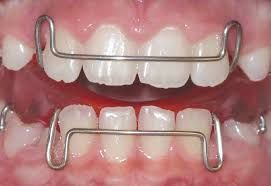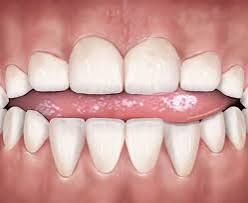General Classification of Anterior Cross Bites
1- Dento-alveolar Anterior Cross Bite ( Teeth-Bone relation)
2- Skeletal Anterior Cross Bite
3- Functional Anterior Cross Bite
It is a type of anterior cross bite in which one or more upper teeth are in lingual or backwards relation to the anterior teeth of the lower jaw and hence the name Dento-alveolar Anterior Cross Bite. It mostly appears as single tooth cross bite usually occuring due to over-retained deciduous teeth that deflect the erupting upper into a palatal position relative to the lower teeth.
It is also generally known as REVERSE OVERJET
The effective mode of correction for this anomaly is the use tongue blades, Catalans appliance and sometimes the use of double cantilever spring movable appliance with posterior cross bite plates.
The functional cross bite is also referred to as Pseudo class III maloclussion which false class III maloclussion where the mandibe is forced to close in a position forward of its true normal centric relation.
The change in the normal centric relation is due to the presence of occlusal prematurities which subsequently causes the deflection of the mandible into a exceedingly forward position beyond its true centric relation during closure. This class of anterior cross bite is corrected by eliminating the cause which is the occlusal prematurities.
Skeletal anterior Cross Bite are usually due to presence of skeletal malrelation or discrepancies in the growth of maxilla or mandible or both. Anterior cross bite of this category could be due to maxillary skeletal retrognathic posture or hypoplasia or could be mandibular prognathism. They are best treated during growth by growth modification procedures such as the use of myofunctional or orthopaedic appliances.
Habits in the Orthodontic vicinity refer to certain actions involving the teeth and other oral or circumoral structure which are done repeatedly enough by some patients to the extent of having profound and damaging effects on the position of the teeth and occlusion.
Some of these habits include thumb sucking, lip biting, tongue thrusting, mouth breathing among others.
Now, let's start with thumb sucking as one of the most common habits by young children.
1- Thumb Sucking
Thumb Sucking is one the habits that is mostly often practiced by children and capable of causing deleterious effects on the Dento-alveolar structures. This habit is considered normal and natural starting from a duration of like 2.5 years to 3 years. However, repetition and persistent indulgence in this habit beyond 3.5 years to 4 years of age can result into disastrous influence and effect on the Dento-alveolar structures and hence should be stopped and intercepted from further progressions.
Thumb Sucking can be intercepted by the use of habit breaking appliances which could be of removable or fixed type.
2- Tongue Thrusting
Tongue thrust is a pathological situation in which the tongue touches any teeth anterior to the molars on swallowing.
It is a provoking and deleterious habit that can clinically presents with an open bite anomaly and anterior proclination which is forward shifting of the anterior teeth.
The tongue thrusting habit could be rectified by habit breakers or through counselling and education on normal and technique of swallowing.
3- Mouth Breathing
Mouth Breathing could be obstructive or habitual in nature leading to disruptive effect on the dentofacial structures.
Obstructive mouth breathing is a non-voluntary action which could a nasal obstruction primarily due to nasal tumours, blocked nasal aperture, nasal polyps, chronic inflammatory nasal infection or could be deviation in the nasal septum anatomical structure.
Habitual mouth breathing is voluntary action or can be considered a conditioned reflex action noticed in a patient where oral breathing persists after the removal of the nasal obstruction.
Chronic mouth breathing condition affects the orofacial equilibrium length, shape and size due to lowered mandibular and tongue posture causing it to have a pigeon appearance and could therefore lead to severe form of maloclussion.
Interceptive approach is to identify and remove the cause as quickly as possible. Vestibular screen appliance is often used to correct persistent habitual form of oral breathing.
Now let's go to the method space gaining Interceptive approach
If a deciduous molar is lost early or prematurely exfoliated and space maintenance is not employed to hold on the space, a reduction in the length of the mesial arch could occur due to the mesial shift of the molar. In a patient which has this anomaly, this lost space can be reoccupied by distal movement of the first molar.
Though not all patients who have lost their arch due to the so called mesial movement could be ideally treated for the space regaining approach.
For effective correction space regaining should done at an early period before the eruption of the second molar.
Some of the widely used methods of space regaining includes the following;
1- Gaber's space regainer
2- Space regains using jack orthodontics screws
3- Regaining space by using the cantilever spring movable appliance
Let's commence with the Gaber's space appliance.
- Garber's space appliance is an orthodontic band or curved crown which is selected for a tooth to be distalized. This appliance comprises a U-shaped hollow like tubing together with a U-shaped rod, string or wire to be inserted into the hollow tubing. The tube is joined at the mesial aspect of the tooth to be moved distally. The U-shaped rod is fitted to the tube in such that it will make a contact with the tooth mesially to the edentulous area.
An open coil of adequate length and elastic strength is embedded around the free space of the U-shaped filling rod fixed together to the assembly of the tube and rod. This open coil generates force by compression which brings about a distal propulsion of the tooth indicated for movement in order to regain the lost space.
-
Space regain by cantilever spring works by distalizing molar tooth using removable appliance that is attached to simple finger springs.
-
Jack screws can also be used in such a way that arch is increased and regained by distalizing the molar tooth which is in opposite direction of the previously occured mesial movement. This assembly comprises a split acrylic plate together with a jack screw joined relative to the edentulous area usually retained with Adam's Clasps.
That's all as regards orthodontics procedures for this post and thanks for the follow-up till this juncture which of lengthy paragraphs.
It would be continued in the subsequent of more procedures of Interceptive orthodontics.
cross-posted from my Blurt Account



Comments